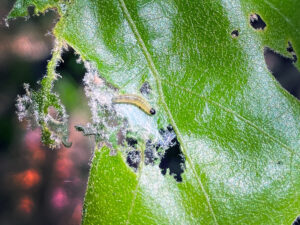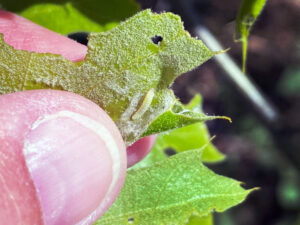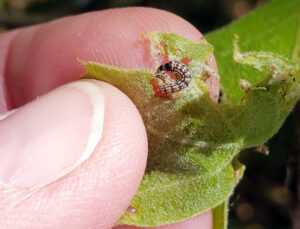
Oak leafroller caterpillars web leaves together as they feed. Photo: Wisconsin DNR.
Linda Williams, DNR Forest Health Specialist, Woodruff
Linda.Williams@wisconsin.gov or 920-360-0665
Watch for defoliators in your oak trees this summer. You may have already heard news reports about spongy moth caterpillar populations being high this year, but there are some native caterpillars to watch for this year as well.
In 2022, oak leafroller caterpillars caused significant defoliation to oaks in areas of northeastern and northwestern Wisconsin, as well as in Blue Mound State Park. Many other areas experienced lesser amounts of defoliation from oak leafroller.

Oak leaftier is a native caterpillar that causes damage similar to that caused by oak leafroller. Photo: Wisconsin DNR.
This year, oak leafroller activity is being seen in the same areas as 2022. Like last year, oak leafroller is causing defoliation even though the caterpillars are still quite small. Several other native insects are also already damaging oak leaves, including the oak leaftier caterpillar and the Chionodes fuscomaculella caterpillar that webs oak leaves together.
While these are all native caterpillars, they can cause significant defoliation. Watch for these caterpillars on your oaks by looking for leaves either rolled up or webbed together, with a caterpillar feeding within. Severely defoliated trees will try to send out additional leaves. Watering defoliated trees during dry periods can help them.

This native caterpillar (Chionodes fuscomaculella) does not have a common name, but feeds on oak leaves, as well. Photo: Wisconsin DNR
Landowners should monitor forest stands for mortality over the next couple of years. Mortality could occur if the forest stand experiences multiple stressors, including multiple years of severe defoliation, a year of significant defoliation combined with a drought period, or other stressors. A salvage timber sale could be considered if significant mortality occurs.
